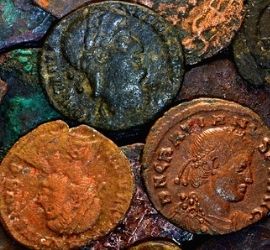Copper ETF Definition
 A copper ETF – Exchange Traded Fund – is designed to track the price of copper. Copper is an industrial metal used in a wide variety of applications in manufacturing, electronics, and construction. However, copper is considered a cyclical commodity whose price fluctuates in tandem with economic cycles. In general, its price rises when the economy grows and falls when the economy slows. Due to its widespread use, some investors use copper and other commodities to diversify their portfolios. Because copper rises when inflation is accelerating, the metal is also seen as a hedge against rising prices.
A copper ETF – Exchange Traded Fund – is designed to track the price of copper. Copper is an industrial metal used in a wide variety of applications in manufacturing, electronics, and construction. However, copper is considered a cyclical commodity whose price fluctuates in tandem with economic cycles. In general, its price rises when the economy grows and falls when the economy slows. Due to its widespread use, some investors use copper and other commodities to diversify their portfolios. Because copper rises when inflation is accelerating, the metal is also seen as a hedge against rising prices.
Gold and silver usually come to mind for most people when precious metals are mentioned. But, there are plenty of other investment opportunities that fall under the precious metals designation. For instance, copper is an important component of electronics. That distinction gives it value worth paying attention to, especially in the digital era. Some believe this commodity has room to grow, while others believe it’s overplayed. Whatever your opinion—bullish or bearish—copper presents an investment opportunity. As with many industries and indexes, one of the easiest ways to give your portfolio exposure to the copper market is with a copper exchange-traded fund (ETF) or exchange-traded note (ETN). Whether you’re looking to hedge risk, invest in copper, or diversify your portfolio, copper ETFs and ETNs give you instant access to the copper sector. Meanwhile, you’ll enjoy the benefits, such as some tax advantages, that come with ETF investments. (Source: thebalance.com)
Copper ETF Examples
The United States Copper Index Fund (CPER)
- Performance over 1-Year: 16.8%
- Expense Ratio: 0.80%
- Annual Dividend Yield: N/A
- 3-Month Average Daily Volume: 62,697
- Assets Under Management: $28.3 million
- Inception Date: November 15, 2011
- Issuer: USCF
CPER is an ETF that is structured as a private investment structure commodity pool. It combines investor contributions in order to trade commodity futures contracts. These commodity pools act as a single entity in order to increase leverage in trading with the goal of maximizing profits. The ETF seeks to track the SummerHaven Copper Index Total Return, which is designed to reflect the performance of the returns from a portfolio of copper futures contracts that are fully collateralized by 3-month U.S. Treasury Bills. CPER invests exclusively in copper futures. (Source: investopedia.com)
Global X Copper Miners ETF (COPX)
COPX replicates of the Solactive Global Copper Miners Index. It is made up of common stocks, GDRs, and ADRs of global companies within the mining industry of the copper market. The approach that this ETF takes is equity-based in exposure to copper. This fund makes investments in copper mining entities with exclusivity in copper that offers a narrower portfolio that is-copper-centric according to the ETF Database. The COPX ETF has an AUM of $93.6 million. The fee charged is 65 basis points annually. The trading volume is approximately 64,000 shares heralding a 19.2% return in 12 months. It provides investors exposure to copper mining companies and is useful for portfolio diversification without the broad approach of including other commodities interests.
First Trust Global Copper Index (CU)
CU invests in the stocks of businesses that are active within the copper mining industry. This strategy is an indirect approach to copper investment. The underlying securities of CU are composed of companies that are not only involved in copper. Other metals also for a more diverse and broad portfolio approach. The attractiveness of CU is that it takes an equity approach that adds exposure to copper without the negative associations of future based strategies. The spot price of metals correlates strongly to the profitability of the included firms that are dependant on copper prices. The weighting methods for fund distribution are linear and based on the revenue exposure to copper production of each security. Commodities within the CU scope include copper, silver, gold, and other metals.
(Sources: investopedia.com & moneyinc.com)
Copper ETN Example
iPath Series B Bloomberg Copper Subindex Total Return ETN (JJC)
- Performance over 1-Year: 15.4%
- Expense Ratio: 0.45%
- Annual Dividend Yield: N/A
- 3-Month Average Daily Volume: 6,411
- Assets Under Management: $19.0 million
- Inception Date: January 17, 2018
- Issuer: Barclays Capital
iPath Series B Bloomberg Copper Subindex Total Return ETN (JJCB)
According to Nasdaq.com, Barclays Capital established the JJCB ETN in January of 2018. The focus of this ETN is to provide exposure to the copper futures price. It joined the industrial metal ETFs at a time when copper prices rallied to record-breaking highs. The driers for the demand of copper have spurred strong global economic growth in this sector, before Covid 19 restrictions. Copper is a metal that is useful in multiple industries within construction and manufacturing. Strong copper markets exist in sync with economic growth. The fund accomplishes two purposes. The first is to provide investors with exposure to copper prices. The second is to take an index of one copper futures contract at a time. The AUM achieved a figure of $10.1 million in just a few days of trading and the fee charged is 45 basis points a year, beating the fees charged by COPX. mi
iPath Dow Jones-UBS Total Return ETN (JJC)
JJC is the market’s oldest copper exchange-traded product. It is an ETN that exists on futures-based strategies with potential credit risks. It links directly to the Dow Jones UBS Commodity Subindex Total Return. The JJC is an index made up of a single copper-centric futures contract. The strategy of this ETN by design exposes investors to changes that occur in the spot price of copper. It also includes the slope of the futures curve. It is an alternative means of tapping into the realm of copper futures contracts.
(Source: moneyinc.com)
Taking the Next Step With A Copper ETF or ETN
If copper funds or notes pique your interest, you should dig into more information on them. You must understand exactly what you’re buying before you invest in any product. This is especially true with ETNs that are built out of complicated derivatives like futures, options, or forwards. No investment asset is risk-free. So, make sure you understand the disadvantages, limitations, and reactions of each product. Also, explore their reaction to different market conditions before you buy.
Additionally, you should research the copper industry as a whole, beyond the performance of any one investment product. For example, 2019 was a volatile year for copper. Analysts with S&P Global noted trade tensions and tariffs between China and the U.S. while writing about the decline in copper prices in 2019. Some investors believe that this recent price decline presents a buying opportunity. Others prefer to steer clear of the copper industry for the time being. Whatever your stance, it’s important that you do the research and digest a wide range of arguments before investing.
(Source: thebalance.com)
How to Buy a Copper ETF or ETN
- Deposit the money – Or, verify the funds you want to use to buy a copper ETF in your brokerage account. The buying and selling of ETF shares are accomplished in the same manner as for stock shares. By placing a buy or sell order through your brokerage account.
- Short term or long term – Decide how long you want to hold a copper position. For example, for longer than a week, or trade short term. If you think copper will decline in value you can buy an inverse copper ETF. At the time of publication, there were five copper tracking ETFs available. The funds with the symbols JJC, CPER, and CUPM directly track the price of copper as it trades on the commodity futures markets. The fund trading under LCPR generates price value changes at two times the price change of copper and SCPR changes a value in the opposite direction of copper prices with twice the value change. LCPR and SCPR are suitable for short-term trading.
- Purchase shares – Select your copper ETF by placing a buy order with the stock symbol and number of shares through your online brokerage account. ETF shares trade on the stock exchange, and your order will be filled almost immediately during market hours. Confirm that the order was filled by checking your account summary page, which should list the copper ETF shares and the purchase price.
(Source: finance.zacks.com)
Copper ETF – Final thoughts
Any investment involves a risk of loss. The copper market is a commodity recommended for portfolio diversification. However, taking the ETF/ETN strategy into account allows for more rapid movement of funds, depending on the stipulations of the agreement. Some ETFs assign new contracts every month. But, others renew or invest in other copper futures contracts on a 3-month basis. While copper futures is a volatile market, there is always an opportunity for investments to show a high yield.
It’s wise to consider which aspect of the copper industry a particular ETF invests in when making the decision about which to include in your investment portfolio. Some are copper-centric. But, others take a broader approach to include companies that are involved with copper and other metals for further diversification. In any event, most offer reliable snapshots of performance concerning the spot prices of metals, which are determined daily. Then, you get a more precise determination of the copper price at any given time.
(Source: moneyinc.com)
Up Next: Day Trading For Beginners – What Is A Day Trader
Day trading is simply buying a stock or security, then, quickly selling or closing out the position. Usually, the position is closed within a single trading day. Ideally, a day trader wants to “cash-out” by the end of each trading day. They want no open positions to avoid the risk of losses by holding security overnight. Day trading is not for everyone and carries significant risks. It requires an in-depth understanding of how the markets work and various strategies for profiting in the short term. Short term profits require a very different approach compared to traditional long term, buy and hold investment strategies.




